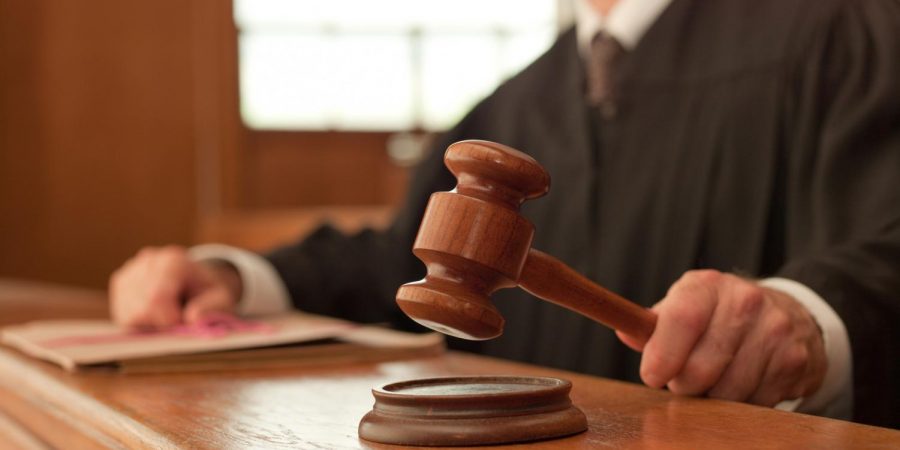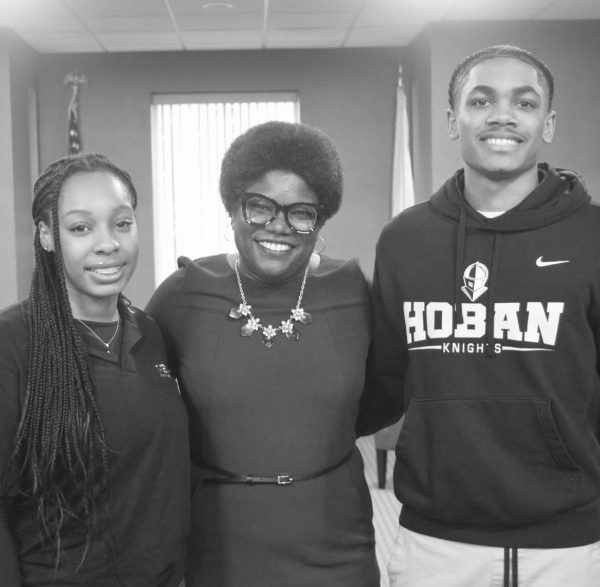Everything you need to know for mock trial tryouts, abridged
At 4:30 tonight, Mr. Orsini’s room is going to be filled with nervous energy. Kids will be rattling off case law and acting in sync with the complex Eli Moss. Everyone will be waiting with bated breath for their names to be called.
Mock Trial Tryouts are here.
For anyone who’s looking for an after school club to get them through the harsh winter months and the even-harsher college application process, Mock Trial is your best bet. Between intense cases and bizarre witnesses, it’s got every element of the best crime shows, with even more drama.
A mock trial team is made up of eight people: two defense attorneys and witnesses, and two state attorneys and witnesses. The team competes against other schools by acting out a case provided by the Ohio Center for Law Related Education at the district, regional, state and national levels. Hoban’s mock trial team is the most successful team in Hoban history, sending a team to the state competition almost every year. Last year’s Team Gold came in first at both the district and regional levels, ending in the top five percent of teams in the state.
But since there’s so little time, and so much to learn, I thought I’d give you a little guide to what you will need to know to succeed this year.
This year’s case is a suppression hearing to throw out evidence in the case of the State vs. Quinn Woolf. Woolf’s fourth amendment may have been violated by the city of Harmony when he was filmed in his backyard. The state has to prove that drone footage, captured by Omniscient Technology while working with the State, was not obtained through the state.
First, let’s talk about being a witness. All of the witness auditions are about Eli Moss.
And what an interesting character he is.
Eli is the owner and CEO of Omniscient Technologies (OMNI), a drone mapping company. He’s a bit of a college kid that never grew up, honestly. He was hired by the state to be a freelance surveyor of state-owned farmland.
If we’re being honest, you have to read his statement to write yours. It’s pretty much impossible to get your character without getting you character, so make sure you read it, ideally more than once.
A quick recommendation for writing your tryout with Eli: avoid specifics when talking about the state.
Don’t associate more than you have to, pretty much. You’re there to tell them that you weren’t working with the state.
Now, onto our attorneys.
First, get a side. You probably want to talk to Mr. Hillery, or visit the list on the bulletin board by the center staircase. Your position in the case dictates your tryout, so there’s no way you’re going in without that.
If you’re worried about the writing portion, one of last year’s varsity team members and a State recognized “Best Attorney,” Brandon Bishop, has a surefire outline for a successful attorney tryout:
- Opening line/case theme
- This should be a shorter, concise sentence written in the active voice that captures the audience’s attention right off the bat. You build off of this and restate it a few times (three or so) throughout the open.
- Case summary
- Summarize what the story is. Don’t include too much unnecessary detail, since you only have two minutes and 30 seconds for tryouts. The legal briefs will help you with this.
- Legal argument
- Explain the burden of proof in the case.
- Application of the burden
- Explain how you will meet that burden/ how the other side won’t. Use language like “today, the ____ will show _____.” For tryouts you’ll have to talk about one witness you’ll call (you’ll do both witnesses in the real deal). Don’t worry if this bit is confusing, we’ll explain it more later.
- Conclusion
- Restate your case theme and tie everything together. It’s crucial that you deliver this effectively. In the conclusion, it’s very standard to say something like, “If the court does not rule in our favor, x will happen,” and you need to end with “therefore, the ___ will ask for the court to rule ______ at the end of today’s trial.”
Next, get to know your witnesses. You have to pick one from your side to hinge your entire case on, so choose wisely.
On the State side, you’ve got Eli Moss. We’ve already discussed this one, so I’m gonna gloss over it. All I’ve got to offer right now is that Eli is important to call, for sure. 10/10 would recommend bringing him in.
Next is police officer Jordan Miller who, in my opinion, is the weakest witness in the case. Eli can do anything that he can, so it’s not really worth it at all. He openly admits that Quinn was the only suspect that they explored, and that the State’s Case depends solely on the stolen laptop. Think twice before shoving him into your open.
The prosecution’s witnesses end with Campbell Bolt, a member of the department of commerce. If you can get past the numerous grammatical errors (it reads like a writing passage from the PSAT), Campbell can help you out in every element of the case. He’s got the contract with Omniscient memorized, and he’s ready to say that it was a private entity.
Defense-wise, we start with Quinn himself. Quinn isn’t your usual witness, since most suppression cases avoid using the defendant, but he’s worth mentioning. He talks about how he was hidden from view. It’s good to shut down the privacy angle from the State, and it puts some emotional support into your argument.
Next is arguably the only expert witness, Dr. Parker Monroe. Monroe is the dude to call on the defense— he gets the drones and the law surrounding them, and it all falls under his witness jurisdiction. Monroe should be a sure thing in every opening tonight.
The last witness is Dylan Ulrich, an… how can I put this… interesting choice. Dylan’s not bad, per se. He’s just weak. He, of course, can testify that Eli was working under the state and with the police. However, be ready to argue against hearsay objections, since Dylan’s testimony mostly consists of Eli’s statements.
So, there. A fast recap of what you need to know for mock trial this year. Now, go forth and channel our lord and savior Annalise Keating.
And, it’s no-cut anyway, so why not?

